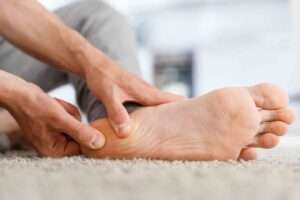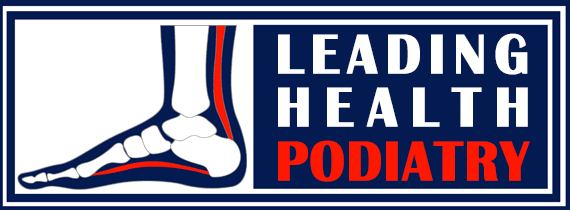Heel Pain
What is Heel Pain?
Heel pain is a common complaint that can interfere with daily activities, making walking, standing, or even just getting out of bed in the morning difficult. Whether it’s a dull ache or a sharp stabbing pain, heel pain can stem from several underlying causes. At Leading Health Podiatry, we offer expert care to identify the source of your heel pain and provide effective treatments to help you return to pain-free movement.
Common Causes of Heel Pain
Heel pain can result from a variety of conditions. Some of the most common causes include:
Plantar Fasciitis: The most frequent cause of heel pain, plantar fasciitis occurs when the plantar fascia (the band of tissue that runs across the bottom of the foot) becomes inflamed. This often causes sharp pain in the heel, particularly when first standing in the morning.
Heel Spurs: Heel spurs are bony growths that develop on the bottom of the heel bone. They often result from long-term plantar fasciitis, though not everyone with a heel spur experiences pain.
Achilles Tendinitis: The Achilles tendon, located at the back of the ankle, can become inflamed due to overuse or strain. Achilles tendinitis can cause pain in the back of the heel and may worsen with physical activity.
Bursitis: Inflammation of the bursae (small fluid-filled sacs) that cushion the joints can cause pain in the heel, especially with pressure or movement.
Stress Fractures: Overuse, such as excessive running or jumping, can lead to tiny cracks in the heel bone, causing pain that worsens with activity.
Tarsal Tunnel Syndrome: Compression of the tibial nerve, which runs along the inside of the ankle, can cause heel pain, tingling, and numbness.
Flat Feet or High Arches: Foot structure plays a significant role in heel pain. Flat feet or high arches can lead to abnormal pressure distribution, contributing to pain in the heel and arch.
Symptoms of Heel Pain
Heel pain can vary in intensity and may be accompanied by other symptoms, including:
- Sharp pain in the heel, especially with the first steps in the morning
- Swelling, redness, or warmth around the heel
- Tenderness when touching the heel
- Discomfort that worsens with activity or after standing for long periods

How We Treat Heel Pain at Leading Health Podiatry
At Leading Health Podiatry, we understand that heel pain can impact your quality of life. Our expert podiatrists use a range of treatments tailored to your individual needs, helping you achieve lasting relief:
Accurate Diagnosis: Identifying the underlying cause of your heel pain is essential for effective treatment. Our podiatrists will perform a comprehensive assessment, including a physical examination, imaging tests if needed, and a discussion of your symptoms and lifestyle.
Custom Orthotics: If your heel pain is caused by foot misalignment or poor posture, we may recommend custom orthotics. These specially designed insoles provide arch support, cushioning, and proper alignment, reducing strain on the heel and promoting healing.
Stretching and Strengthening Exercises: In many cases, heel pain is linked to tight muscles or weak foot structures. Our podiatrists can provide targeted exercises to stretch the plantar fascia, Achilles tendon, and calf muscles, as well as strengthen the muscles that support the foot and ankle.
Massage and Manual Therapy: Therapeutic massage can alleviate pain in the heel and surrounding muscles. We may also use manual therapy techniques to improve joint mobility and reduce stiffness in the foot and ankle.
Shockwave Therapy: If your heel pain is persistent and unresponsive to other treatments, extracorporeal shockwave therapy may be an option. This non-invasive treatment uses high-energy sound waves to stimulate healing in the affected tissue and promote tissue regeneration.
Footwear Advice: Wearing the right shoes is key to managing and preventing heel pain. Our team will advise you on footwear that provides the necessary support and cushioning for your condition.
Taping and Strapping: Techniques like Kinesio taping can help provide additional support to the foot and heel, reducing strain on the tissues and promoting healing.
Anti-Inflammatory Measures: For inflammation-related heel pain, we may recommend anti-inflammatory treatments, including cold therapy or corticosteroid injections, to reduce swelling and provide pain relief.
Night Splints: For conditions like plantar fasciitis, night splints can be worn while you sleep to gently stretch the plantar fascia, alleviating morning pain and stiffness.


Why Choose Leading Health Podiatry for Heel Pain Treatment?
At Leading Health Podiatry, we are dedicated to helping you find relief from heel pain. Our experienced team of podiatrists offers personalised care, tailoring treatment plans to address your specific condition and lifestyle. Whether you’re dealing with heel spurs, plantar fasciitis, or any other form of heel pain, we are here to guide you through every step of your recovery journey.
Contact Leading Health Podiatry for Heel Pain Treatment
If you’re suffering from heel pain, don’t wait any longer to seek treatment. Our team at Leading Health Podiatry is here to help you find lasting relief. Contact us today to schedule an appointment and start your journey to pain-free feet.
